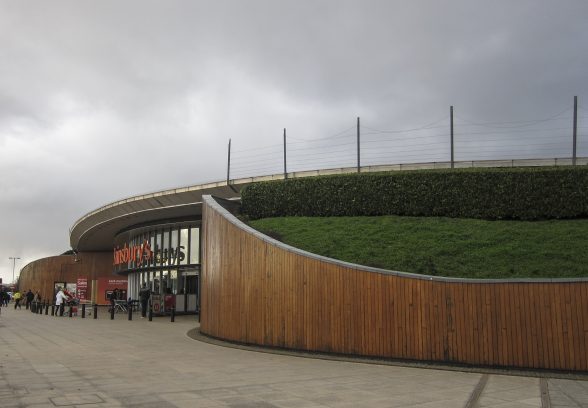This website uses cookies
This website uses cookies to enable it to function properly and to analyse how the website is used. Please click 'Close' to accept and continue using the website.



The Twentieth Century Society is calling for the first ever eco-designed supermarket to be saved from demolition and listed at grade II *. The Sainsbury’s on the Greenwich peninsula, south east London, which opened on the eve of the millennium in autumn 1999, is threatened with redevelopment.
This pioneering and award winning retail store, which is under 15 years old, would be the youngest building, and the first ever purpose built supermarket, to be listed. It is scheduled for demolition and replacement with an IKEA superstore.
The Twentieth Century Society is supporting a campaign to save the building led by Paul Hinkin, formerly of Chetwood Associates, the supermarket’s original architect. The Twentieth Century Society submitted a listing application to English Heritage today.
The building represents a complete re-thinking of traditional supermarket design. Every aspect of the standard retail ‘shed’ was reassessed to maximise energy efficiency, minimise the impact on the environment and improve the experience for customers.
When it opened, the award winning store scored the highest ever official environmental rating for a retail building with a perfect 31 out of 31 points, and was the first store to be awarded an “excellent” BREEAM rating.
Catherine Croft, Twentieth Century Society Director said, “Not only would the demolition of such a recent building be a tragic waste of energy and resources, but this supermarket is outstandingly important. It is the most innovative retail store to have been built in the UK in the last 50 years.”
“To date no other supermarket buildings have even been assessed for their architectural or historical interest – and yet they are an incredibly important. Practically everyone has been to a supermarket at one point or another. This one is the best and most obvious candidate for listing,” added Croft.
Paul Hinkin said: “Sainsbury’s Greenwich is a paradigm shift in public building which must be preserved. If its wanton destruction is permitted, it will do irreparable harm to the cause of sustainable development in the UK. ”
“The bioclimatic design principles which form the DNA of the building, coupled with its pioneering user centered design philosophy, have created a unique and new sustainable architecture, ” added Hinkin.
The opening of the Sainsbury’s Greenwich store in 1999 by Jamie Oliver was widely covered in the national press. Although there was keen popular interest in the building’s sustainability credentials, its architectural quality was also widely recognised. Reviews published at the time noted that ‘in appearance as well as sustainable design, the new building breaks with the dismal supermarket tradition of large, rectangular, artificially lit sheds’ (Building, 1999).
The RIBA Journal (November 1999) stated that: “The form of the external design is frankly lovely. The main entrance elevation uses surprisingly welcoming materials, with the main glazed entrance flanked by untreated oak boarded drums with flank walls, earth mounds and turfed slopes. The service areas are masked using site reclaimed stones within wire gabion baskets filled with demolition waste and planted with creepers and alpines.”
Everything from the form of the building to the choice of materials was carefully chosen both for its appearance and for its sustainability credentials. Many of the materials are recycled, such as the entrance lobby floor made from recycled aircraft and car tyres and the toilet wall panelling of melted recycled plastic bottles.
The building’s innovation and architectural merit were recognised through a number of awards, including:
• shortlisting for the Stirling Prize (we believe no other supermarket has been shortlisted for this prize before or since);
• selection by the Design Council as a Millennium Product;
• the RIBA Journal Sustainability Award winner;
• a RIBA Regional Award 2000 winner;
• the Design Museum’s Design Sense Award;
• Retail Week Store Design of the Year 2000;
• Channel 4 Building of the Year People’s Choice 2000.
An online petition against the demolition has been set up by Paul Hinkin http://www.petitionbuzz.com/petitions/stopikea. It has been signed by almost 800 people including the former President of RIBA Angela Brady and Mayor of Bristol George Ferguson. The planning application for the proposed demolition is set to be determined at the Royal Borough of Greenwich’s planning committee in March.
Ends:
For more information please contact Catherine Croft or Henrietta Billings: Henrietta@c20society.org.uk 0207250 3857
Please credit images to the Twentieth Century Society

Become a C20 member today and help save our modern design heritage.